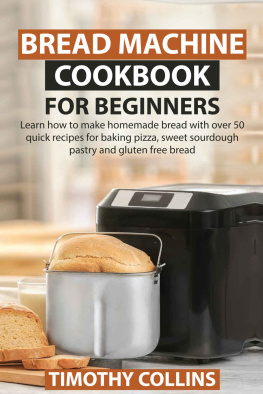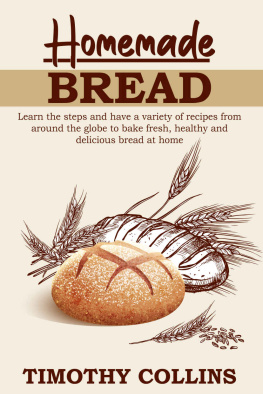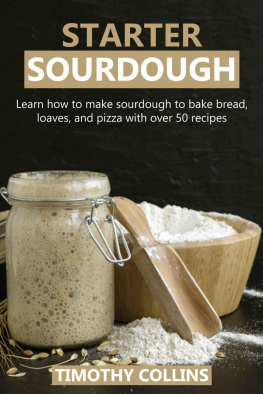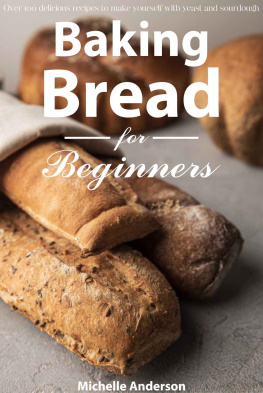Bread Machine Cookbook for Beginners
Learn how to make homemade bread with over 50 quick recipes for baking pizza, sweet sourdough pastry and gluten free bread
By
Timothy Collins
Copyright 2020 b y Timothy Collins- All rights reserved.
This document is geared towards providing exact and reliable information in regard to the topic and issue covered. The publication is sold with the idea that the publisher is not required to render accounting, officially permitted, or otherwise, qualified services. If advice is necessary, legal or professional, a practiced individual in the profession should be ordered.
From a Declaration of Principles which was accepted and approved equally by a Committee of the American Bar Association and a Committee of Publishers and Associations.
In no way is it legal to reproduce, duplicate, or transmit any part of this document in either electronic means or in printed format. Recording of this publication is strictly prohibited and any storage of this document is not allowed unless with written permission from the publisher. All rights reserved.
The information provided herein is stated to be truthful and consistent, in that any liability, in terms of inattention or otherwise, by any usage or abuse of any policies, processes, or directions contained within is the solitary and utter responsibility of the recipient reader. Under no circumstances will any legal responsibility or blame be held against the publisher for any reparation, damages, or monetary loss due to the information herein, either directly or indirectly.
Respective authors own all copyrights not held by the publisher.
The information herein is offered for informational purposes solely and is universal as so. The presentation of the information is without contract or any type of guarantee assurance.
The trademarks that are used are without any consent, and the publication of the trademark is without permission or backing by the trademark owner. All trademarks and brands within this book are for clarifying purposes only and are the owned by the owners themselves, not affiliated with this document.
Table of Contents
Introduction
A bread machine or bread maker is a home appliance designed to convert raw ingredients into baked pieces of bread. It consists of a bread pan (or "tin"), with one or more built-in paddles at the bottom, placed in the center of a small special-purpose oven. This small oven is normally operated by a control panel via a simple built-in device using the input settings. Some bread machines have specific cycles for various styles of dough including white bread, whole grain, European-style (sometimes called "French"), and dough-only (for pizza dough and formed loaves baked in a traditional oven). Some also have a timer to enable the bread machine to work without attendance from the operator, and some high-end models allow the user to program a customized period.
The first bread maker was launched by Matsushita Electric Industrial Co. (now Panasonic) in Japan in 1986, based on a year of work by project engineers and software developer Tanaka, who trained with the head baker at Osaka Hotel to know how to knead bread optimally and involved inserting special ribs inside the machine. The machines of the Funai Electric Company added a fan for cooling bread and claimed to make the first automatic bread machine.
How a bread machine works: you put the paddle inside the pan. You weigh the ingredients with tin out of the oven and load them up. Then you need to do is, pick the setting you want to use from the electronic control panel, close the lid, and wait. If you have a glass lid in your bread maker, you can see what they are doing. If the cover is opaque, the imagination will have to be listened to and used. One of the first sounds you will hear is the motor whirling on the pump as the paddle turns round, kneading the dough. Then, during the rising phase, everything will go quiet. Next, during the proving, you can hear more kneading and another time of stillness. Finally, the oven turns on, you will see steam coming up through the exhaust vent, and a few minutes later, you will start smelling the delicious aroma of baking bread. The basic process of bread making is mostly automatic, but most devices come with books of the recipe to make more sophisticated types of dough.
Main ingredients of bread are water, salt, sugar, flour and yeast. Different types of flours are available like whole wheat flour, white wheat flour, bread flour and all-purpose flour. Three types of yeast are available: active dry yeast, instant yeast and rapid rise yeast.
Yeast bread is a bread whose dough rises as a result of the gas being created as the grain ferments during the bread-making process.
Most leavened bread uses industrial baker yeast to assist the rise of the dough. Traditional sourdough fermentation, however, relies on "wild yeast" and lactic acid bacteria, which naturally occur in flour to leaven the bread.
Wild yeast avoids acidic conditions more than baker's yeast. That's what helps it to work with bacteria that generate lactic acid to help the dough rise.
The mixture of wild yeast, lactic acid bacteria, flour, and water used to produce sourdough bread is called a "starter." The starter ferments the sugars in the bread dough during the bread-making process, allowing the bread to rise and develop its characteristic flavor.
Sourdough bread must ferment and grow much longer than other types of bread, which is what produces its distinctive texture.
Celiac disease is a severe autoimmune disease that occurs in genetically predisposed people, where gluten ingestion causes damage to the small intestine. One in every 100 people worldwide is estimated to be affected. Two and a half million Americans are undiagnosed and are at risk for complications of long-term health.
If anyone with celiac disease eats gluten (a protein found in wheat, rye, and barley), their body mounts an immune response which attacks the small intestine. These attacks result in damage to the villi, small finger-like projections that line the small intestine that facilitates the absorption of nutrients. When the villi get damaged, nutrients cannot be properly absorbed into the body.
Sourdough breads is very useful for celiac patients.
Chapter 1: Introduction of Bread Making Machine
Bread is a baked meal that can be made from various types of flour. The dough usually consists of water and flour. Bread is made in hundreds of shapes, sizes, characteristics, and textures. Proportions and forms of flour and other ingredients vary, as do preparation methods.
Bread has been one of the essential foods in history, as it is one of the oldest artificial foods, too. In fact, people made bread from the dawn of farming.
With every meal of the day, people of all cultures eat the bread in various ways. It can be eaten as part of the meal, or as an individual snack. Bread can be baked in the oven or can be made in bread makers. People usually bake bread in the oven. Yet more and more people turn to special bread machines at home to bake fresh bread.
1.1 What is a Bread Machine?
A bread maker, or bread machine, is a kitchen gadget. The tool consists of a bread pan or tin with built-in paddles, placed in the center of a small multi-purpose, special oven.

Different types of bread machines
Majority of bread making devices would be a little different. This is because every variation of a bread maker is built to serve a specific purpose. Below we'll be addressing the most common types of bread makers available in the modern market.
Vertical
Most bread machines bake loaves, which are placed vertically, as the shape of baking tin is vertical. This bread machine style features one kneading paddle only.
Next page







